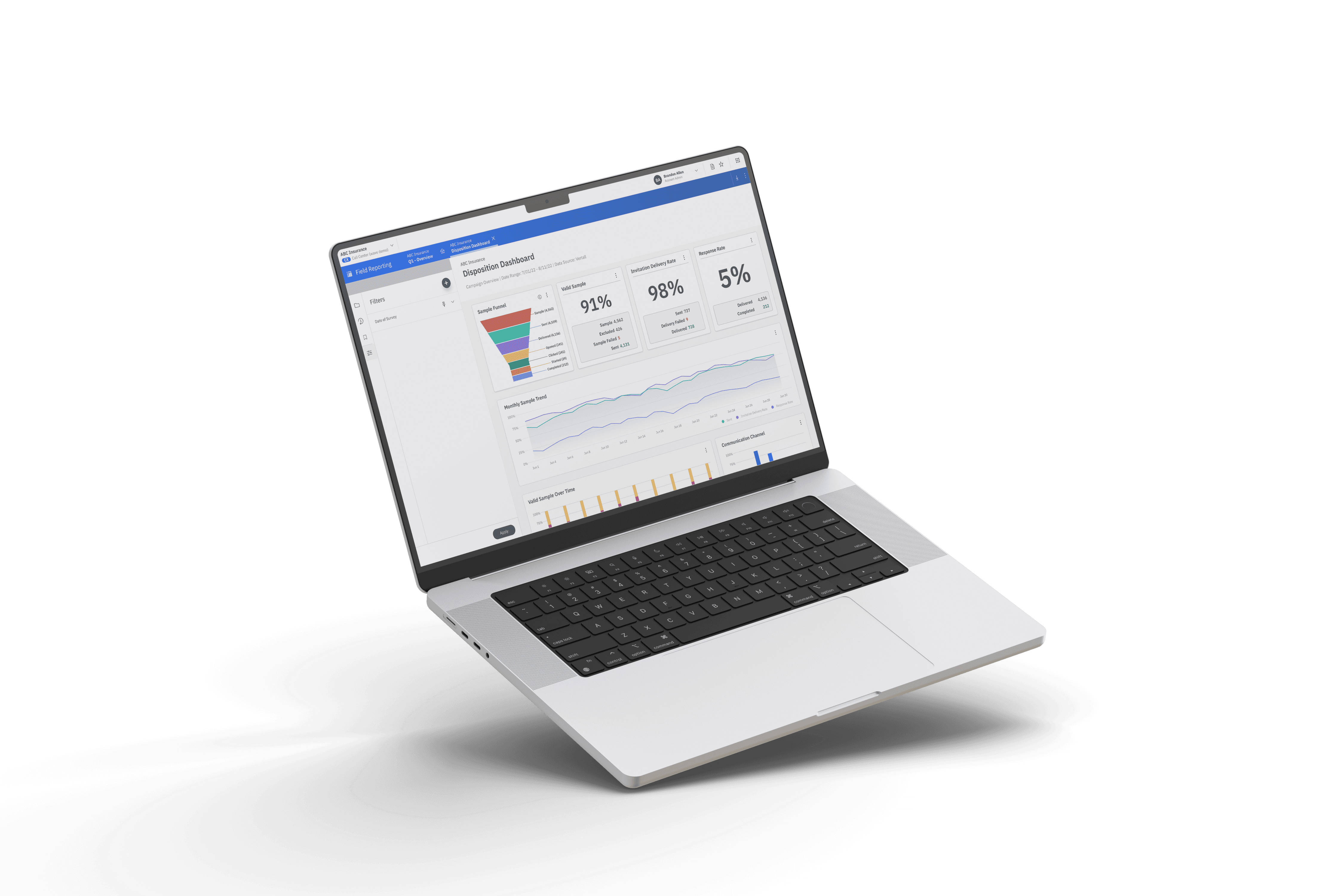SAAS Survey data platform
Survey Data Dashboard
InMoment faced a critical business challenge: understanding and improving customer experience when:
20% of customers had no contact details
Survey fatigue rules excluded another 20%
Average response rates were only 10%
Only 6% of customers shared critical experience insights
We needed to redesign the Disposition Reporting feature—originally a merger of two acquired companies (BrandXP and MaritzCX)—and integrate it seamlessly into our Field Reporting Platform to increase visibility of these valuable insights.
Timeline
7 weeks (while managing multiple concurrent projects)
User Research
I conducted 12 stakeholder interviews with internal experts and 8 client interviews to understand pain points with the existing "Campaign Insights" feature. Key findings included:
Difficulty accessing critical survey response data
Inconsistent visualization between platforms
Limited filtering capabilities
Inability to export or share insights easily
Requirement Gathering
I facilitated 3 collaborative workshops with the product, development, and customer success teams to:
Document technical constraints and opportunities
Map user journeys for different personas (executives, managers, and analysts)
Prioritize features based on user needs and technical feasibility
Create a comprehensive requirements document with user stories
Competitive Analysis
I analyzed 5 competitor products and created a feature comparison matrix to identify opportunities for differentiation and innovation.
Testing & Optimization
Met with InMoment internal experts to hear concerns and validate what was talked about in the hand-off meeting. Using FullStory and help from our dev teams, we found insights in the platform's interaction data. After merging this with data from the internal interviews, we reviewed sessions from our top client's custom dashboards.
We needed to think pretty far ahead to have a clear idea of what steps needed to happen first. This involved a lot of back and forth with dev teams, product and other design teams. Our biggest hurdle was to overcome intended data visualizations and if it would connect well with other parts of our platform for a seamless experience.
Low-Fidelity Exploration
Created paper sketches exploring 4 different information architecture approaches
Developed wireframes for key user flows using Adobe XD and Miro
Conducted informal testing with 5 internal stakeholders to validate initial concepts
Mid-Fidelity Prototyping
Evolved wireframes into mid-fidelity interactive prototypes
Incorporated feedback from initial testing
Created multiple visualization options for each data type
Tested with 3 client representatives to validate usability
High-Fidelity Design
Developed comprehensive UI components following InMoment's design system
Created detailed specifications for interactive elements
Designed responsive layouts for various screen sizes
Produced a clickable prototype for final validation
Participated in daily standups with the development team
Created detailed component specifications using Zeplin
Developed an interactive design-to-code documentation guide
Collaborated directly with frontend engineers to address implementation challenges
Conducted regular design QA reviews as features were implemented
Client Delivery & Iteration (1 Week)
Presented the final solution to 3 key clients for feedback
Created training materials and onboarding documentation
Developed a phased rollout plan with the product team
Established metrics for measuring success post-launch
Intelligent Filtering
AI algorithms analyze user preferences, tags, and snippets of feedback to generate optimized data sets. Users can:
Filter by response status, date ranges, and custom parameters
Save and share filter configurations
Set up automated alerts for specific data patterns
Customized Dashboard Widgets
Flexible visualization options aligned with company preferences
Drag-and-drop dashboard customization
Role-based widget recommendations
Ability to add, remove, and resize widgets as needs change
Drill-Through Data Exploration
Intuitive drill-down into sample data sets
Customizable drill-through preferences and priorities
Seamless switching between summary and detailed views
Export capabilities for further analysis
Measurable Outcomes
Increased Efficiency: 43% reduction in time spent analyzing survey data
Improved Data Visibility: 72% of users reported better insight discovery
User Adoption: 89% of eligible users actively using the platform within 3 months
Client Satisfaction: NPS score increased by 18 points for clients using the new dashboard
Positive User Feedback
High user satisfaction ratings and positive reviews highlight the app's intuitive interface and powerful AI capabilities.
Internal Impact
Solution became a reference design for other platform integrations, design patterns were incorporated into the company design system, and methodology was adopted for future feature migrations.
This project reinforced the importance of cross-functional collaboration and early user involvement. By bringing together product, design, and development teams from the beginning, we were able to create a solution that balanced user needs with technical constraints while meeting business objectives.
Our biggest challenge was reconciling legacy data structures with new visualization capabilities, which required close collaboration with data engineers and frontend developers to ensure performance and accuracy.








